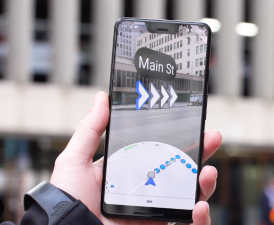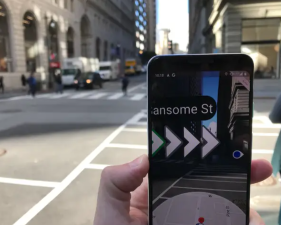AR real-scene navigation uses a camera to capture the real scene of the road ahead in real time, and then combines the current location of the car, map navigation information and scene AI recognition for fusion calculation, and then generates a virtual navigation guidance model and superimposes it on the real road, thereby creating a navigation screen that is closer to the driver's real vision, greatly reducing the user's reading cost of traditional 2D or 3D electronic maps.
Secondly, it improves the ability to ensure the safety of users' driving. AR navigation can perform intelligent image recognition of passing vehicles, pedestrians, lane lines, traffic light positions and colors, speed limit signs and other surrounding environments, and provide drivers with a series of driving safety assistance functions such as vehicle distance monitoring, collision warning, pedestrian warning, lane departure reminder, front vehicle start reminder, and traffic light reminder, bringing a more refined and safer service experience than traditional map navigation.
AR real-scene navigation uses a camera to capture the real scene of the road ahead in real time, and then combines the current location of the car, map navigation information and scene AI recognition for fusion calculation, and then generates a virtual navigation guidance model and superimposes it on the real road, thereby creating a navigation screen that is closer to the driver's real vision, greatly reducing the user's reading cost of traditional 2D or 3D electronic maps.
Secondly, it improves the ability to ensure the safety of users' driving. AR navigation can perform intelligent image recognition of passing vehicles, pedestrians, lane lines, traffic light positions and colors, speed limit signs and other surrounding environments, and provide drivers with a series of driving safety assistance functions such as vehicle distance monitoring, collision warning, pedestrian warning, lane departure reminder, front vehicle start reminder, and traffic light reminder, bringing a more refined and safer service experience than traditional map navigation.
Advantages of AR navigation
- Real-time real-scene navigation:
Compared with traditional 2D map navigation, AR navigation can display the road conditions and routes ahead of the user in real time, allowing users to understand the surrounding environment and travel direction more intuitively.
- Accurate route:
AR navigation uses high-precision positioning technology and map data to provide users with accurate route guidance and reduce the risk of getting lost.
- Strong interactivity:
Users can perform gesture operations on the AR navigation interface, such as zooming in, zooming out, rotating, etc., to easily view routes and surrounding information.
- Rich surrounding information:
AR navigation not only provides route guidance, but also displays information about surrounding restaurants, shopping, attractions, etc., and recommends the best route for users.
- Applicable to a variety of scenarios:
Whether driving, cycling or walking, AR navigation can provide users with accurate route guidance.
Practical application
- Urban travel:
In complex urban roads, AR navigation can help users easily find their destination and avoid getting lost.
- Scenic spot tour:
In scenic spots, AR navigation can provide tourists with real-time route guidance and attraction introductions to enhance the tour experience.
- Shopping in shopping malls:
In large shopping malls, AR navigation can guide users to quickly find their favorite stores and save shopping time.
- Subway travel:
Combined with the subway line map, AR navigation can provide users with accurate transfer instructions to avoid missing stations.
The core of AR navigation technology is to use technology to eliminate the cognitive gap between "virtual information and real space". In the future, with the maturity of 5G and IoT technology, this kind of "what you see is what you get" navigation mode may become the standard infrastructure of smart scenes.



